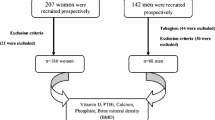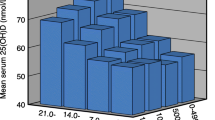Abstract
This study seeks to estimate the status of serum 25-hydroxyvitamin D [25(OH)D] in a healthy section of the population in Tunisia and to compare the achieved results with other published data. A transverse descriptive inquiry was carried out between January and March 2002. Three hundred and eighty-nine subjects aged 20–60 years were included in the study. A questionnaire was used to investigate clinical characteristics: sunlight exposure to ultraviolet light and, for women, parity, breast feeding, whether or not they wore the veil, and menopause. A dietary investigation estimated calcium and vitamin D intake. Morning fasting blood was collected from each subject for the measurement of the following parameters: serum calcium, phosphorus, albumin, alkaline phosphatase, 25(OH)D, parathyroid hormone (PTH). Hypovitaminosis D was defined by a cut-off of 37.5 nmol/l. The population studied was largely female, for the greater part housewives. The accumulated prevalence of hypovitaminosis D was 47.6%, increasing with age. Hypovitaminosis is highly prevalent in women (P<0.001). Multiparity, menopause, wearing the veil, and calcium and vitamin D dietary intake are factors associated with hypovitaminosis D (P<0.05). Analysis of logistic regression shows that only multiparity and vitamin D dietary intake are independent predictive factors. The status of serum 25(OH)D in Tunisia resembles that in southern European countries rather than in Middle Eastern countries. Insufficient vitamin D diet intake, higher parity and wearing the veil explain this deficiency in Tunisia. Dietary enrichment or supplementation by vitamin D and a more outdoor lifestyle, especially for older people, should be seriously considered as a way to reduce this deficiency in Tunisia.
Similar content being viewed by others
References
Gannagé-Yared MH, Brax H, Asmar A,Tohmé (1998) Statut vitaminique D des sujets âgés. Etude de la population libanaise. Presse Méd 27:900–904
Jacques PF, Felson DT, Tucker KL, Mahnken B, Wilson PW, Rosenberg IH, Rush D (1997) Plasma 25-hydroxyvitamin D and its determinants in an elderly population sample. Am J Clin Nutr 66:929–936
Pfitzenmeyer P, Monnier V, d’Athis Ph et al. (1995) L’hyperparathyroïdie secondaire du sujet âgé. A propos de 200 dosages de PTH intacte. Presse Méd 24:299–303
Theiler R, Stahlein HB, Tyndall A, Binder K, Somorjai G, Bischoff HA (1999) Calcidiol, calcitriol and parathyroid hormone serum concentrations in institutionalized and ambulatory elderly in Switzerland. Int J Vit Nutr Res 69:96–105
Fardellone P, Sebert JL, Garabedian M et al. (1995) Prévalence et conséquences biologiques de l’insuffisance vitaminique D chez le sujet âgé institutionnalisé. Rev Rheum 62:613–618
Reggy P van der Wielen, Michiel R H Löwik, Henk van der Berg et al. (1995) Serum vitamin D concentrations among elderly people in Europe. Lancet 346:207–210
McKenna MJ (1992) Differences in vitamin D status between countries in young adults and in the elderly. Am J Med 93:69–77
Nakamura K, Nashimoto M, Hori Y, Yamamoto M (2000) Serum 25 hydroxyvitamin D concentrations and related dietary factors in peri and postmenopausal Japanese women. Am J Clin Nutr 71:1161–1165
Gannagé-Yared MH, Thomé A, Halaby A (2001) L’hypovitaminose D, un problème majeur de santé publique. Presse Méd 30:653–657
Haddad JG (1992) Vitamin D—solar rays, the Milky Way or both? N Engl J Med 326:1213–1215
Holick MF (1995) Environmental factors that influence the cutaneous productive of vitamin D. Am J Clin Nutr 61:638S–645S
Ghannam NN, Hammani MM, Bakheet SM, Khan BA (1999) Bone mineral density of the spine and femur in healthy Saudi females: relation to vitamin D status, pregnancy and lactation. Calcif Tissue Int 65:23–28
El Sonbaty MR, Abdul-Ghaffar NU (1996) Vitamin D deficiency in veiled Kuwaiti women. Eur J Clin Nutr 50:315–318
Gannagé-Yared MH, Chemali R, Yaacoub N, Halaby G (2000) Hypovitaminosis D in a sunny country: relation to lifestyle and bone markers. J Bone Miner Res 15:1856–1862
Author information
Authors and Affiliations
Corresponding author
Rights and permissions
About this article
Cite this article
Meddeb, N., Sahli, H., Chahed, M. et al. Vitamin D deficiency in Tunisia. Osteoporos Int 16, 180–183 (2005). https://doi.org/10.1007/s00198-004-1658-6
Received:
Accepted:
Published:
Issue Date:
DOI: https://doi.org/10.1007/s00198-004-1658-6




